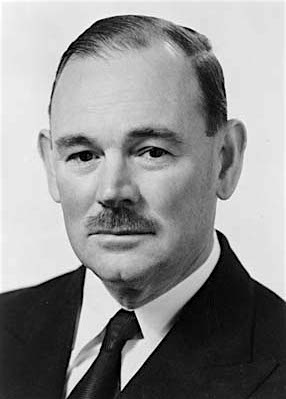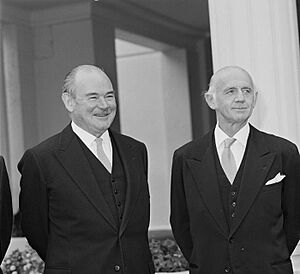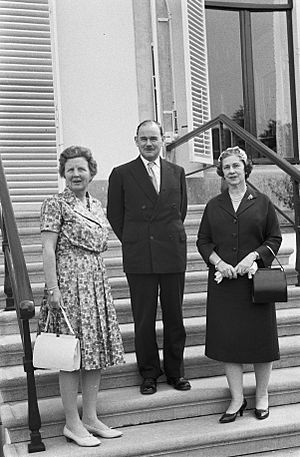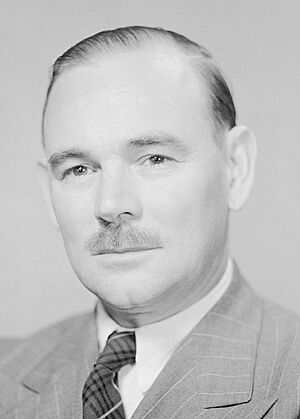Paul Hasluck facts for kids
Quick facts for kids
Sir Paul Hasluck
|
|
|---|---|

Hasluck in 1960
|
|
| 17th Governor-General of Australia | |
| In office 30 April 1969 – 11 July 1974 |
|
| Monarch | Elizabeth II |
| Prime Minister | John Gorton William McMahon Gough Whitlam |
| Preceded by | The Lord Casey |
| Succeeded by | Sir John Kerr |
| Minister for External Affairs | |
| In office 24 April 1964 – 11 February 1969 |
|
| Prime Minister | Robert Menzies Harold Holt John McEwen John Gorton |
| Preceded by | Garfield Barwick |
| Succeeded by | Gordon Freeth |
| Minister for Defence | |
| In office 18 December 1963 – 24 April 1964 |
|
| Prime Minister | Robert Menzies |
| Preceded by | Athol Townley |
| Succeeded by | Shane Paltridge |
| Minister for Territories | |
| In office 11 May 1951 – 18 December 1963 |
|
| Prime Minister | Robert Menzies |
| Preceded by | Richard Casey |
| Succeeded by | Charles Barnes |
| Member of the Australian Parliament for Curtin |
|
| In office 11 December 1949 – 12 February 1969 |
|
| Preceded by | Division created |
| Succeeded by | Victor Garland |
| Personal details | |
| Born |
Paul Meernaa Caedwalla Hasluck
1 April 1905 Fremantle, Western Australia, Australia |
| Died | 9 January 1993 (aged 87) Dalkeith, Western Australia, Australia |
| Resting place | Karrakatta Cemetery |
| Political party | Liberal Party of Australia |
| Spouse |
Alexandra Darker
(m. 1932) |
Sir Paul Meernaa Caedwalla Hasluck (born April 1, 1905 – died January 9, 1993) was an important Australian leader. He served as the 17th Governor-General of Australia from 1969 to 1974. Before that, he was a politician for the Liberal Party. He held important government jobs for many years, from 1951 to 1969.
Paul Hasluck was born in Fremantle, Western Australia. He went to Perth Modern School and the University of Western Australia. After finishing university, he worked there as a history teacher. During World War II, he joined the government's Department of External Affairs. He was also Australia's first representative to the United Nations from 1946 to 1947.
In 1949, Hasluck was elected to the federal parliament for the Liberal Party. He quickly became a minister in 1951. He was in charge of Australia's territories like Papua New Guinea and the Northern Territory. Later, he was the Minister for Defence and the Minister for External Affairs. He was in these roles during the Vietnam War.
In 1969, he became the Governor-General. This is the Queen's representative in Australia. He worked well with different prime ministers during his time. After retiring, he wrote many books, including his own life story and books on Australian history.
Contents
Early Life and Education
Paul Hasluck was born on April 1, 1905, in Fremantle, Western Australia. He was one of five children. His parents were very religious and worked for the Salvation Army. The family often struggled financially because of their missionary work.
Paul grew up in different places across Western Australia. These included York, Kalgoorlie, and Collie. In 1916, his family moved back to Perth.
He attended Perth Modern School from 1918 to 1922 after winning a scholarship. He was good at debating. Later, he studied at the University of Western Australia. He earned a diploma in journalism in 1932 and a Bachelor of Arts degree in 1937.
Journalism and History Work
After school, Paul Hasluck started working at The West Australian newspaper in 1922. He covered many different topics, from court news to sports and politics. He became responsible for the newspaper's team at Parliament House. He also wrote a weekly column about state politics.
He became friends with John Curtin, who later became a prime minister. While working at the newspaper, Hasluck also started writing articles about Western Australian history. After getting his Master's degree, he taught history at the University of Western Australia.
In 1932, he married Alexandra Darker. They had two sons. Alexandra also became a famous writer and historian. She was the first woman to be made a Dame of the Order of Australia.
In 1941, during World War II, Hasluck joined the Department of External Affairs. He attended important international meetings, including the one that created the United Nations. After the war, he returned to the University of Western Australia. He was asked to write two books about Australia's role in World War II.
Becoming a Politician
Paul Hasluck decided to enter politics because he disagreed with some government policies. In the 1949 election, he ran for the Liberal Party. He won the seat of Division of Curtin in Perth.
In 1951, Prime Minister Robert Menzies made Hasluck the Minister for Territories. He held this job for twelve years. He was in charge of Australia's territories, including Papua New Guinea and the Northern Territory. He worked to help these territories move towards self-government.
He also made important changes for Aboriginal people in the Northern Territory. He helped create the Welfare Ordinance 1953. This law changed how Aboriginal people were treated.
Later, Hasluck was the Minister for Defence from 1963 to 1964. Then he became the Minister for External Affairs. He held this role during the Vietnam War. He strongly supported Australia's involvement in the war. He also worked to make Australia's relationship with the United States stronger.
Trying for Leadership
In December 1967, Prime Minister Harold Holt disappeared. Hasluck put his name forward to become the new Liberal Party leader. He wanted to offer an alternative to another politician, William McMahon.
Many Liberal politicians thought Hasluck was too old at 64. They also felt he was too traditional and not good enough on television to compete with the Labor leader, Gough Whitlam. So, they chose John Gorton, who was younger and more aggressive.
Governor-General of Australia

In early 1969, Prime Minister Gorton offered Hasluck the job of Governor-General. Hasluck accepted and left Parliament on February 10, 1969. He was sworn in as Governor-General on April 30, 1969.
During his time as Governor-General, two different prime ministers were in office: William McMahon and Gough Whitlam. Even though Whitlam and Hasluck had disagreed in the past, they worked together respectfully.
After Whitlam won the 1972 election, he asked Hasluck to quickly swear him and his deputy into office. This allowed them to start governing right away. Hasluck agreed, showing their good working relationship.

In 1974, Hasluck allowed Whitlam to call a double dissolution election. This meant both houses of Parliament would be dissolved for an election. Hasluck's term as Governor-General was ending in July 1974. Whitlam offered to extend it, but Hasluck declined. His wife did not want to stay at Government House longer than planned.
His last official act as Governor-General was to open the 29th Parliament on July 9, 1974. His successor, Sir John Kerr, was sworn in two days later.
Life After Retirement
After his term, Sir Paul Hasluck retired to Perth. He remained involved in cultural and political activities until he passed away in 1993. He was buried at Karrakatta Cemetery.
Many historians believe that if Hasluck had still been Governor-General in 1975, a major constitutional crisis that year might have ended differently. Hasluck himself hinted at this in his writings and interviews. He believed the Governor-General should not get involved in political disputes.
After his death, his son Nicholas Hasluck published some of his father's private writings. These books contained Paul Hasluck's thoughts and opinions about many people he knew.
A bronze tablet in St Georges Terrace, Perth commemorates Sir Paul Hasluck. This tablet is part of a series honoring important figures in Western Australia's history. His special banner as a Knight of the Garter is displayed in St George's Cathedral, Perth.
Honours and Awards
Sir Paul Hasluck received many honours for his service:
- In 1966, he was made a Privy Counsellor.
- In 1969, he was appointed a Knight Grand Cross of the Order of St Michael and St George (GCMG).
- In 1970, Queen Elizabeth II personally appointed him a Knight Grand Cross of the Royal Victorian Order (GCVO).
- In 1971, he received the Commemorative Medal for the 2500th Anniversary of the founding of the Persian Empire.
- In 1979, he was made a Knight Companion of the Order of the Garter (KG).
The federal voting area called the Division of Hasluck is named after both Sir Paul and his wife, Dame Alexandra Hasluck.
Coat of Arms
 |
|


